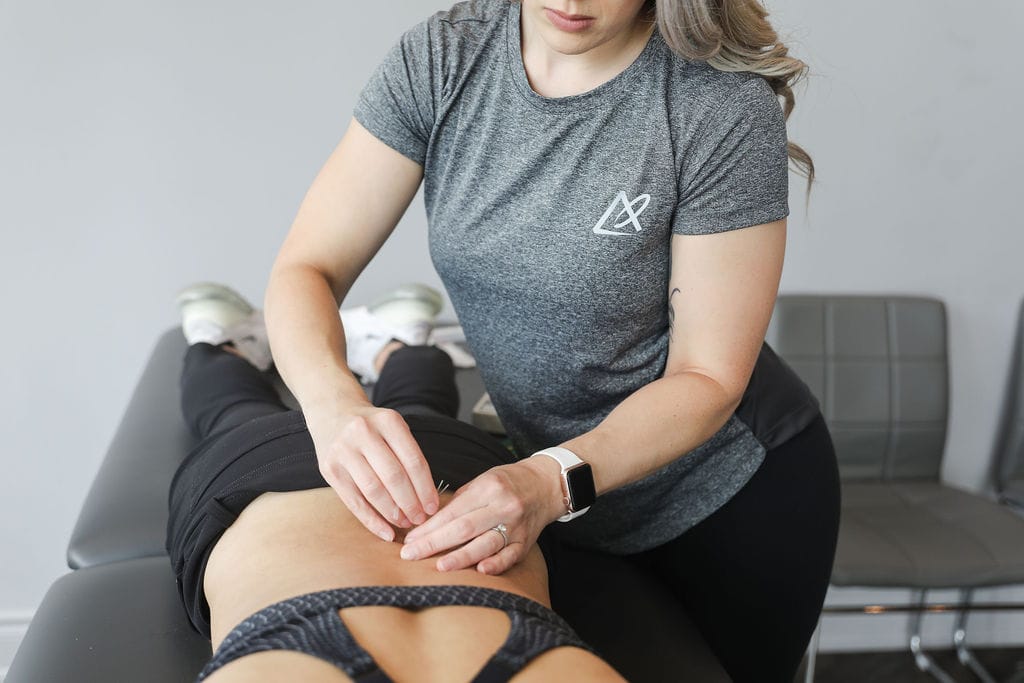Back Pain is a common condition that affects a lot of people worldwide. The causes of back pain can vary from physical injuries to sports injuries and pregnancy.

What are the causes of back pain?
Back pain can be caused due to various reasons like poor posture, overuse, or injury but many more causes can lead to back pain like inflammation and degenerative disc disease.
What are the common conditions of the back that the physiotherapists in Oakville can treat?
Some of the conditions most frequently treated by physiotherapists at our Physiotherapy Clinic in Oakville are:
- Sciatica
- Postural issues
- Degenerative Disc Disease
- Mechanical Back Pain
- Pregnancy-related back pain
- Disc Herniation
What type of treatments can help back pain?
At Triangle Physiotherapy Oakville, our physiotherapists use manual therapy, exercises, and pain management strategies to help with back pain. It is important to keep moving and staying active to avoid the recurrence of episodes.
Where can I find a physiotherapist in Oakville?
We have 8 locations with physiotherapists to help you.
- Pelvic Health Physiotherapy Etobicoke – Triangle Physiotherapy Etobicoke
- Oakville Pelvic Health – Triangle Physiotherapy Oakville
- Pelvic Health Physiotherapy North York – Triangle Physiotherapy North York
- Mississauga Pelvic Health – Triangle Physiotherapy Mississauga
- Downtown Pelvic Health – Triangle Physiotherapy King West
- Uptown Toronto Pelvic Health – Triangle Physiotherapy Lawrence Park
- Pelvic Physiotherapy Downtown Toronto – Triangle Physiotherapy Queens Quay
- Mississauga Pelvic Health – Triangle Physiotherapy Erin Mills
Our Oakville Physiotherapy Clinic is located only 2 lights West of Highway 403 on Dundas and 2 lights East of Trafalgar Road on Dundas.
“Effective back pain treatment is essential for improving your quality of life. Triangle Physiotherapy offers expert services across the GTA, including Physiotherapy in Etobicoke, Oakville, North York, Toronto, Lawrence Park, Queens Quay, Erin Mills, Mississauga, and Liberty Village. Our skilled physiotherapists are dedicated to helping you find relief from back pain and restore your mobility.”
Back pain is one of the most common ailments we see in our practice.
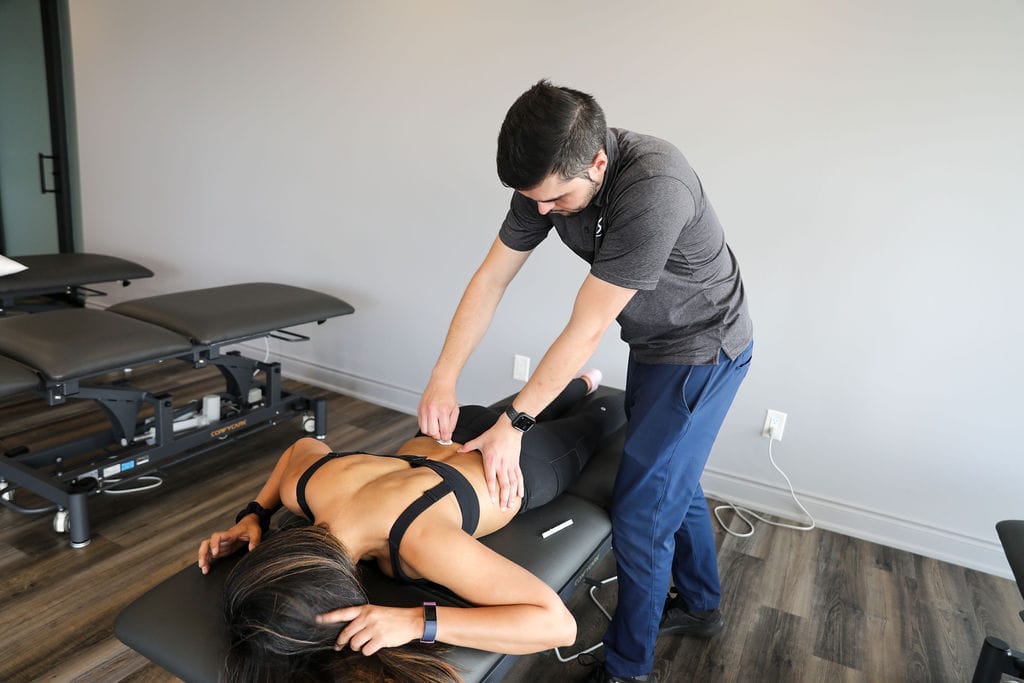
Here are some self-care measures you can consider to manage or prevent recurrence:
- Rest: Give your back a break by avoiding activities that may exacerbate the pain. However, avoid prolonged bed rest, as it can lead to stiffness and muscle weakness. Gentle movement and stretching are usually better than complete immobility.
- Ice and Heat: Apply ice packs to the affected area for the first 48 hours to reduce inflammation, then switch to heat therapy (e.g., heating pads) to relax tight muscles. Use each for 15-20 minutes at a time.
- Over-the-Counter Pain Relief: Non-prescription pain relievers such as ibuprofen (Advil) or acetaminophen (Tylenol) can help alleviate pain and reduce inflammation. Follow the recommended dosage and consult a healthcare professional if you have concerns.
- Exercise: Gentle, low-impact exercises can help strengthen your back and improve flexibility. Activities like swimming, walking, or yoga can be beneficial. Consult a physical therapist for guidance on appropriate exercises.
- Posture: Maintain good posture when sitting and standing to reduce strain on your back. Use ergonomic chairs and accessories if needed, and avoid prolonged periods of sitting.
- Proper Lifting Technique: When lifting heavy objects, bend at your knees and hips instead of your waist, and use your legs to lift while keeping the object close to your body.
- Core Strengthening: Strengthening your core muscles (abdominals, obliques, and lower back) can provide better support for your spine. Pilates and specific core exercises can help with this.
- Sleep: Ensure you have a comfortable mattress and pillow that support your spine. Sleeping on your side with a pillow between your knees can help maintain proper alignment.
- Stress Reduction: Stress can contribute to muscle tension and pain. Techniques such as meditation, deep breathing exercises, and relaxation techniques may help manage stress.
- Weight Management: Maintaining a healthy weight can reduce the strain on your back and decrease the risk of back pain.
- Physiotherapy: A physical therapist can provide personalized exercises and techniques to address your specific back pain issues.
- Chiropractic Care or Massage Therapy: Some people find relief through chiropractic adjustments or therapeutic massages. Consult with professionals in these fields to see if it’s appropriate for your condition.
- Avoid Smoking: Smoking can impair blood flow to the spine and hinder the healing process.
If your back pain persists, worsens, or is accompanied by other concerning symptoms (such as numbness, tingling, weakness, or loss of bladder or bowel control), seek immediate medical attention. Always consult a healthcare provider before starting any new exercise or treatment regimen, especially if you have underlying health conditions or are taking medications. They can provide a more accurate diagnosis and recommend the best treatment options for your specific situation.
How do I book an appointment with a physiotherapist or chiropractor near me?
Click HERE to book an appointment with a physiotherapist or chiropractor at one of our eight locations.
- Physiotherapy Etobicoke – Triangle Physiotherapy Etobicoke
- Oakville Physiotherapy Clinic – Triangle Physiotherapy Oakville
- Physiotherapy North York – Triangle Physiotherapy North York
- Mississauga Physiotherapy Clinics – Triangle Physiotherapy Mississauga
- Downtown Physiotherapy Clinics – Triangle Physiotherapy King West
- Uptown Physiotherapy Clinics – Triangle Physiotherapy Lawrence Park
- Physiotherapy Clinic Downtown Toronto – Triangle Physiotherapy Queens Quay
- Physiotherapy Clinics Mississauga – Triangle Physiotherapy Erin Mills
“Relieving back pain requires a comprehensive approach that includes targeted physiotherapy. Triangle Physiotherapy offers expert services across the GTA, including Physiotherapy in Etobicoke, Oakville, North York, Toronto, Lawrence Park, Queens Quay, Erin Mills, Mississauga, and Liberty Village. Our experienced physiotherapists can help you find effective solutions to alleviate your back pain and improve your quality of life.”
You should consider seeing a physiotherapist when you’re experiencing pain or discomfort, or have mobility issues that affect your daily activities and quality of life. Physiotherapists are healthcare professionals trained to diagnose and treat a wide range of musculoskeletal and movement-related conditions.

Here are some situations in which you might want to consult a physiotherapist:
- Pain and Discomfort: If you’re experiencing persistent pain, whether it’s in your joints, muscles, or any part of your body, a physiotherapist can help identify the root cause and provide treatment to alleviate the pain.
- Injury Recovery: If you’ve suffered an injury, such as a sprain, strain, fracture, or sports-related injury, a physiotherapist can guide you through a rehabilitation program to regain strength, flexibility, and function.
- Mobility Issues: If you’re having trouble moving, walking, or performing daily activities due to stiffness or limited range of motion in your joints, a physiotherapist can develop exercises and techniques to improve your mobility.
- Post-Surgery Rehabilitation: After surgeries, such as joint replacements or orthopedic procedures, a physiotherapist can help you recover faster and regain normal function through targeted exercises and therapies.
- Chronic Conditions: Physiotherapy can help manage chronic conditions like arthritis, fibromyalgia, or chronic back pain by improving muscle strength, joint flexibility, and overall functional capacity.
- Postural Problems: If you have poor posture that’s leading to discomfort or pain, a physiotherapist can assess your posture and provide guidance on how to improve it.
- Neurological Conditions: Physiotherapists also work with individuals who have neurological conditions such as stroke, multiple sclerosis, or Parkinson’s disease to improve movement, balance, and coordination.
- Preventive Care: Even if you’re not currently experiencing pain, a physiotherapist can provide guidance on exercises and habits that can help prevent future injuries and maintain overall musculoskeletal health.
- Sports Performance Enhancement: Athletes can benefit from physiotherapy to improve their performance, prevent injuries, and receive specialized training techniques.
- Pregnancy and Postpartum Care: Physiotherapists can assist pregnant individuals with managing pain and discomfort associated with pregnancy and can provide exercises to help with postpartum recovery.
It’s important to note that physiotherapists work closely with other healthcare professionals, and they will often collaborate to provide you with comprehensive care. If you’re unsure whether seeing a physiotherapist is appropriate for your situation, consider consulting your primary care physician or a medical professional for guidance.
At Physiotherapy Oakville, our team works hand-in-hand with doctors, specialists, and other healthcare providers to ensure you receive the most comprehensive and effective treatment. Scientific studies have shown that a multidisciplinary approach to care can significantly improve patient outcomes. By joining Physiotherapy Oakville, you benefit from a coordinated and collaborative healthcare experience that addresses all aspects of your condition, providing you with a well-rounded and practical path to recovery.
How do I book an appointment with a physiotherapist near me?
Click HERE to book an appointment with a physiotherapist or chiropractor at one of our eight locations.
- Physiotherapy Etobicoke – Triangle Physiotherapy Etobicoke
- Oakville Physiotherapy Clinic – Triangle Physiotherapy Oakville
- Physiotherapy North York – Triangle Physiotherapy North York
- Mississauga Physiotherapy Clinics – Triangle Physiotherapy Mississauga
- Downtown Physiotherapy Clinics – Triangle Physiotherapy King West
- Uptown Physiotherapy Clinics – Triangle Physiotherapy Lawrence Park
- Physiotherapy Clinic Downtown Toronto – Triangle Physiotherapy Queens Quay
- Physiotherapy Clinics Mississauga – Triangle Physiotherapy Erin Mills
“Knowing when to see a physiotherapist can make a significant difference in your recovery and overall well-being. Triangle Physiotherapy offers expert services across the GTA, including Physiotherapy in Etobicoke, Oakville, North York, Toronto, Lawrence Park, Queens Quay, Erin Mills, Mississauga, and Liberty Village. Our experienced team is here to help you address any physical concerns early on and guide you toward optimal health.”
Shoulder pain can vary in its cause and severity, and whether it goes away on its own depends on several factors. Here are some considerations:
- Cause of Shoulder Pain
- Acute vs. Chronic Pain
- Severity of Pain
- Age and Health Status
- Activity Level
- Professional Evaluation
- Treatment Options

What are some Common Shoulder Problems and how to treat them?
Shoulder problems can encompass a range of conditions and injuries. Here are some common shoulder problems and some general guidelines on how they are typically treated:
- Rotator Cuff Tears:
- Treatment can range from rest and physiotherapy for partial tears to surgical repair for complete tears.
- Tendinitis (Rotator Cuff Tendinitis):
- Rest, ice, anti-inflammatory medications, and physiotherapy are common initial treatments. Severe cases may require corticosteroid injections.
- Bursitis (Shoulder Bursitis):
- Similar to tendinitis, treatment includes rest, ice, anti-inflammatory drugs, and physiotherapy. In some cases, corticosteroid injections may be used.
- Frozen Shoulder (Adhesive Capsulitis):
- Physiotherapy and stretching exercises are often recommended. Severe cases may require manipulation under anesthesia or surgery.
- Shoulder Impingement:
- Rest, ice, physiotherapy, and modifications to activity are typical treatments. Injections or surgery may be necessary in severe cases.
- Labral Tears (SLAP Tears):
- Non-surgical options include rest and physiotherapy. Severe cases may require arthroscopic surgery to repair the labrum.
- Shoulder Instability (Shoulder Dislocation):
- Initial treatment includes immobilization and physiotherapy. Surgical options may be considered for recurrent dislocations.
- Arthritis (Osteoarthritis or Rheumatoid Arthritis):
- Management includes pain relief with medications, physiotherapy, and lifestyle modifications. In severe cases, joint replacement surgery may be recommended.
- Fractures (Clavicle, Humerus, or Scapula):
- Treatment depends on the type and severity of the fracture. Options include immobilization with a cast or sling, surgery, and physiotherapy.
- AC Joint Separation:
- Mild cases may require rest and physiotherapy, while severe cases may require surgery.
- Nerve Compression (Thoracic Outlet Syndrome):
- Treatment may involve physiotherapy, posture correction, and occasionally surgery to relieve compression on nerves and blood vessels.
How do I book an appointment at a Physiotherapy Clinic near me?
Click HERE to book an appointment with a physiotherapist or chiropractor at one of our eight locations.
- Physiotherapy Etobicoke – Triangle Physiotherapy Etobicoke
- Oakville Physiotherapy Clinic – Triangle Physiotherapy Oakville
- Physiotherapy North York – Triangle Physiotherapy North York
- Mississauga Physiotherapy Clinics – Triangle Physiotherapy Mississauga
- Downtown Physiotherapy Clinics – Triangle Physiotherapy King West
- Uptown Physiotherapy Clinics – Triangle Physiotherapy Lawrence Park
- Physiotherapy Clinic Downtown Toronto – Triangle Physiotherapy Queens Quay
- Physiotherapy Clinics Mississauga – Triangle Physiotherapy Erin Mills
“Shoulder pain can be persistent and may not resolve on its own without proper care. Triangle Physiotherapy offers expert services across the GTA, including Physiotherapy in Etobicoke, Oakville, North York, Toronto, Lawrence Park, Queens Quay, Erin Mills, Mississauga, and Liberty Village. Our skilled physiotherapists can help you address the root causes of your shoulder pain and guide you towards effective recovery.”
Getting the most out of your physiotherapy appointment involves effective communication, preparation, and active participation.
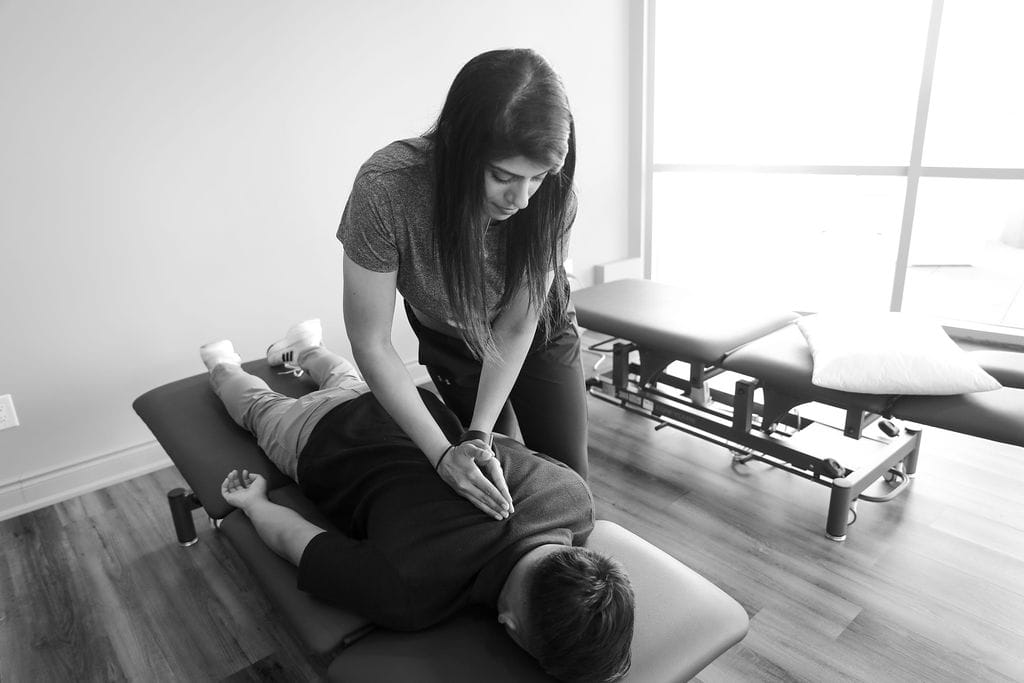
Here are some tips to help you make the most of your physiotherapy session:
- Be Prepared:
- Write down your symptoms, concerns, and questions beforehand.
- Note any changes in your condition since your last appointment.
- Bring relevant medical reports, imaging results, or a list of medications you’re taking.
- Arrive Early:
- Arriving a few minutes early will give you time to complete any necessary paperwork and relax before your session.
- Effective Communication:
- Clearly describe your symptoms, their onset, severity, and any factors that worsen or alleviate them.
- Be honest about your lifestyle, activities, and habits that could impact your condition.
- Ask questions if you don’t understand something. Your physiotherapist is there to help you.
- Set Clear Goals:
- Discuss your goals with your physiotherapist. What do you want to achieve through physiotherapy? This could be pain relief, improved mobility, or functional goals.
- Follow Instructions:
- Listen carefully to the advice and instructions provided by your physiotherapist.
- Follow the recommended exercises, stretches, or home-care routines diligently.
- Ask Questions:
- Don’t hesitate to ask questions about your condition, treatment plan, exercises, or any concerns you might have.
- Understand Your Treatment Plan:
- Make sure you understand your treatment plan, including the goals, expected outcomes, and duration of treatment.
- Take Notes:
- Jot down key points, exercises, or recommendations during the session so you can refer back to them later.
- Feedback:
- Provide feedback to your physiotherapist about your progress and any changes you’ve noticed.
- Be Patient:
- Understand that progress may take time. Don’t get discouraged if you don’t see immediate results.
- Follow Up:
- Schedule follow-up appointments as recommended by your physiotherapist to monitor your progress and make adjustments to your treatment plan.
- Hygiene and Attire:
- Wear comfortable clothing that allows easy access to the area being treated.
- Maintain good hygiene, especially if your session involves physical contact.
- Engage Actively:
- Participate actively during the session. Follow your physiotherapist’s instructions and give your best effort during exercises.
Remember, your physiotherapist is there to help you achieve your goals and improve your health and well-being. By being proactive, engaged, and open in your communication, you can maximize the benefits of your physiotherapy appointments.
How do I book an appointment at a Physiotherapy Clinic near me?
Click HERE to book an appointment with a physiotherapist or chiropractor at one of our eight locations.
- Physiotherapy Etobicoke – Triangle Physiotherapy Etobicoke
- Oakville Physiotherapy Clinic – Triangle Physiotherapy Oakville
- Physiotherapy North York – Triangle Physiotherapy North York
- Mississauga Physiotherapy Clinics – Triangle Physiotherapy Mississauga
- Downtown Physiotherapy Clinics – Triangle Physiotherapy King West
- Uptown Physiotherapy Clinics – Triangle Physiotherapy Lawrence Park
- Physiotherapy Clinic Downtown Toronto – Triangle Physiotherapy Queens Quay
- Physiotherapy Clinics Mississauga – Triangle Physiotherapy Erin Mills
“Maximizing the benefits of your physiotherapy appointment is essential for a successful recovery. Triangle Physiotherapy offers expert services across the GTA, including Physiotherapy in Etobicoke, Oakville, North York, Toronto, Lawrence Park, Queens Quay, Erin Mills, Mississauga, and Liberty Village. Our skilled physiotherapists are committed to helping you achieve your health goals with personalized care and guidance.”
Physiotherapy can be beneficial for individuals with arthritis. Arthritis is a condition that involves inflammation and stiffness of the joints, leading to pain and reduced mobility. Physiotherapy aims to improve joint function, alleviate pain, and enhance overall quality of life through various techniques and exercises. Here are some frequently asked questions (FAQs) about physiotherapy and its role in managing arthritis:
What is arthritis or osteoarthritis?

- Arthritis, also known as Osteoarthritis (OA), is one of the most common causes of a decrease in mobility and an increase in disability among older adults. It is a common condition affecting the joints, most often the knees, hips, lower back, neck, and fingers.
- In a typical joint, there is a smooth layer of cartilage over the surfaces of the bones. This cartilage has several purposes, including distributing weight evenly during movement to minimize friction and absorb any shock.
- In OA, this cartilage breaks down and causes bones to rub against each other, producing pain and, therefore, disuse of that joint. Muscle weakness due to decreased use is a commonly associated issue in osteoarthritis, which affects function and mobility in many ways.
Can physiotherapy help with the pain?
Yes, physiotherapy can help manage arthritis pain by utilizing techniques such as manual therapy, joint mobilization, and soft tissue manipulation. These techniques can help reduce pain and improve joint function.
Can physiotherapy prevent joint deformities in arthritis patients?
Early intervention through physiotherapy can help prevent or minimize joint deformities by maintaining joint function, improving muscle balance around the affected joints, and promoting proper biomechanics.
Can physiotherapy reduce the need for medication?
In some cases, successful physiotherapy can lead to reduced reliance on pain medications or other arthritis-related drugs. However, this should always be discussed with a healthcare professional.
How long does it take to see results from physiotherapy for arthritis?
The timeline for seeing results can vary based on the severity of arthritis, the individual’s response to treatment, and consistency in following the physiotherapy program. Some individuals may experience improvements within a few weeks, while others might require more time.
Is physiotherapy suitable for all types of arthritis?
Physiotherapy can be beneficial for various types of arthritis, including osteoarthritis, rheumatoid arthritis, ankylosing spondylitis, and psoriatic arthritis. However, the approach may vary depending on the specific type and individual needs.
At Physiotherapy Oakville, our experienced physiotherapists create customized treatment plans tailored to the type of arthritis you have and your unique requirements. Scientific research supports the effectiveness of physiotherapy in managing arthritis symptoms, reducing pain, and improving joint function. By joining Physiotherapy Oakville, you can take advantage of evidence-based treatments and individualized care strategies that help you manage arthritis more effectively, enhance your quality of life, and maintain your mobility and independence.
How can strength training help arthritis?
- The strength in the muscles surrounding a joint is directly related to the progression of osteoarthritis. Studies show that muscle weakness after decreased use of the joint due to pain can actually make OA progress faster, further exacerbating the disability. In normal aging, there can already be some underlying muscle wasting or weakness, making function even more difficult.
- The goals of strength training are to decrease pain, protect against worsening of the condition, and improve self-efficacy and general health/well-being. Below are some ways strength training can help OA:
- Improve joint mechanics by offloading the join with stronger muscles
- Reduce joint pain by normalizing neural firing patterns
- Decrease cartilage degeneration by decreasing inflammatory chemicals in the body that breakdown cartilage
- Decrease depression and anxiety by increasing self-efficacy, independence, and mobility
- Older adults without existing osteoarthritis can lower their chances of getting it with increased strength!
What does the evidence show?
- Pain decreased by almost 50% in as little as 2 months of strength training
- Improve walking distance by 30-45%
- Significantly decrease progression of OA in the long-term, up to 30 months after beginning strengthening exercise
What are some of the changes I can expect to see after seeing a physiotherapist?
Changes you will see!
- Easier to go up and down the stairs
- Less pain during squatting and kneeling tasks
- Ability to walk longer and faster, allowing you to enjoy outdoor activities
- Better mood and decreased emotional stress
What are some exercises to do for arthritis?
Examples of exercises
- Swimming
- great for taking the weight of your joints but challenging your muscles against the weight of the water!
- Squatting up and down from a chair
- You do this every day and it will translate directly into easier activities of daily living!
- Biking
- Another very functional, strengthening exercise that also incorporates aerobic training to increase overall health
- Single leg balance
How do I book an appointment at a Physiotherapy Clinic near me?
Click HERE to book an appointment with a physiotherapist or chiropractor at one of our eight locations.
- Physiotherapy Etobicoke – Triangle Physiotherapy Etobicoke
- Oakville Physiotherapy Clinic – Triangle Physiotherapy Oakville
- Physiotherapy North York – Triangle Physiotherapy North York
- Mississauga Physiotherapy Clinics – Triangle Physiotherapy Mississauga
- Downtown Physiotherapy Clinics – Triangle Physiotherapy King West
- Uptown Physiotherapy Clinics – Triangle Physiotherapy Lawrence Park
- Physiotherapy Clinic Downtown Toronto – Triangle Physiotherapy Queens Quay
- Physiotherapy Clinics Mississauga – Triangle Physiotherapy Erin Mills
“Physiotherapy can play a significant role in managing arthritis by improving joint function and reducing pain. Triangle Physiotherapy offers expert care across the GTA, including Physiotherapy in Etobicoke, Oakville, North York, Toronto, Lawrence Park, Queens Quay, Erin Mills, Mississauga, and Liberty Village. Our experienced physiotherapists can help you develop a personalized treatment plan to manage arthritis and enhance your quality of life.”
✔️ Physiotherapy absolutely works!
Physiotherapy is a legitimate and effective healthcare practice that aims to improve and restore physical function and mobility, reduce pain, and enhance overall well-being. It is commonly used to treat a wide range of conditions, injuries, and illnesses. Physiotherapists, also known as physical therapists, are trained healthcare professionals who use various techniques, exercises, and modalities to help patients recover from injuries, manage chronic conditions, and improve their physical capabilities.
What is Physiotherapy?
- Physiotherapy is used to help people affected by injury, illness, or disability through movement, exercise, manual therapy, education, and advice.
- At Triangle Physiotherapy, we work in partnership with our patients to help them recover and stay well.
- We use advanced techniques along with evidence-based care. The utilization of these skills allows our physiotherapists to assess, diagnose, treat, and prevent a wide range of health conditions and movement disorders.
What are the benefits of physiotherapy treatment?
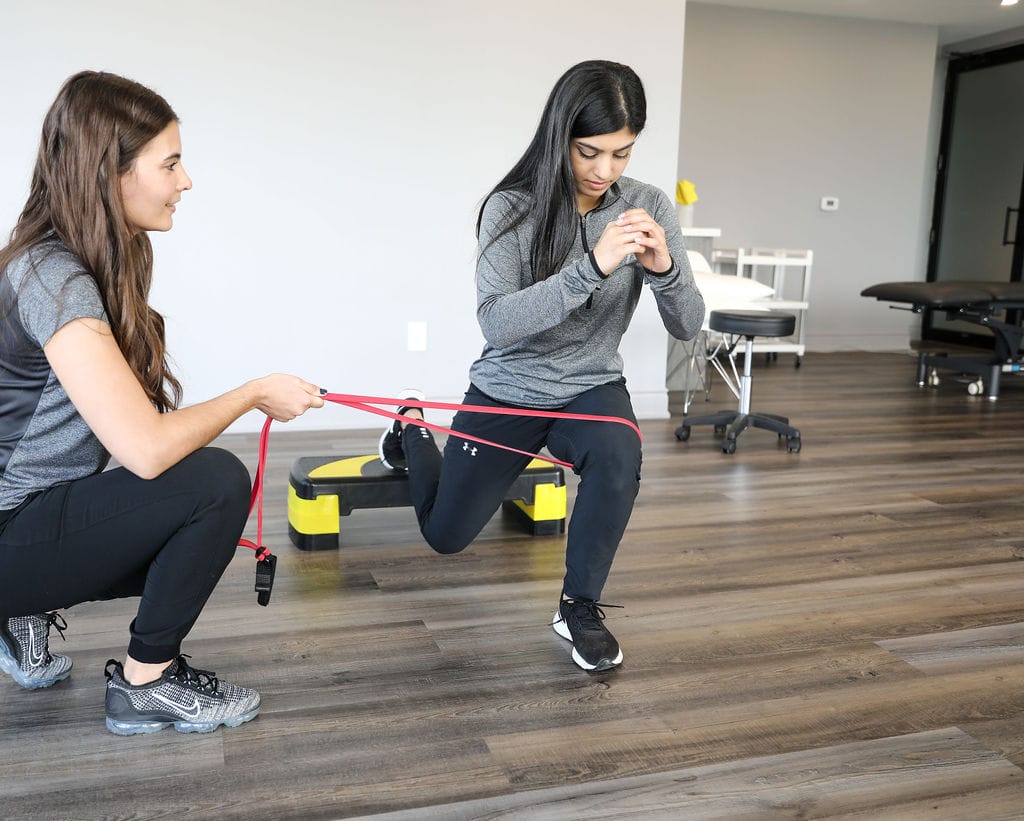
- Injury Rehabilitation: Physiotherapists play a crucial role in rehabilitating injuries, such as sprains, strains, fractures, and surgeries. Physiotherapists develop personalized treatment plans to help patients regain strength, flexibility, and mobility.
- Pain Management: Physiotherapy techniques, including manual therapy, massage, and therapeutic exercises, can help reduce pain and discomfort associated with musculoskeletal issues, neurological conditions, and chronic pain.
- Neurological Conditions: Physiotherapy is used to improve motor function, balance, and coordination in individuals with neurological conditions such as stroke, Parkinson’s disease, multiple sclerosis, and spinal cord injuries.
- Cardiopulmonary Rehabilitation: Physiotherapy is involved in rehabilitating individuals with heart and lung conditions, helping them regain cardiovascular fitness and respiratory function.
- Posture and Ergonomics: Physiotherapists can provide guidance on maintaining proper posture and ergonomics to prevent musculoskeletal problems and discomfort.
- Sports Injuries: Physiotherapy is commonly used in sports medicine to treat and prevent sports-related injuries, enhance athletic performance, and aid in sports-specific training.
- Geriatric Care: Physiotherapy can help older adults maintain their independence, improve mobility, and manage age-related conditions like arthritis and osteoporosis.
- Pediatric Conditions: Physiotherapists work with children to address developmental delays, congenital conditions, and other pediatric issues that affect mobility and physical function.
- Preventive Care: Physiotherapists can provide education and exercises to prevent injuries and improve overall physical health and fitness.
- Pelvic Health: Pelvic Floor Physiotherapy refers to a specific and advanced field within physiotherapy that deals with Pelvic Floor Dysfunction. Pelvic Floor Dysfunction can impact people of any age or gender and the term describes several conditions that may affect the urinary, reproductive, digestive, sexual, and/or stability systems in the pelvis. Pelvic Health Physiotherapists have post-graduate training in pelvic health and can resolve many pelvic floor issues in people of all genders and ages.
- Cancer Rehabilitation: Cancer rehabilitation can help you to lessen and overcome these side effects and help you to participate in all your meaningful daily activities. The goal of cancer rehabilitation is to thus improve your daily function and physical and mental well-being both during and after your cancer treatments. Triangle Physiotherapy has trained physiotherapists that provide cancer rehabilitation services to help manage the common side effects of cancer and cancer treatment.
How do I get the most out of my Physiotherapy Appointment?
Getting the most out of your physiotherapy appointment involves effective communication, preparation, and active participation. Here are some tips to help you make the most of your physiotherapy session:
- Be Prepared:
- Write down your symptoms, concerns, and questions beforehand.
- Note any changes in your condition since your last appointment.
- Bring relevant medical reports, imaging results, or a list of medications you’re taking.
- Arrive Early:
- Arriving a few minutes early will give you time to complete any necessary paperwork and relax before your session.
- Effective Communication:
- Clearly describe your symptoms, their onset, severity, and any factors that worsen or alleviate them.
- Be honest about your lifestyle, activities, and habits that could impact your condition.
- Ask questions if you don’t understand something. Your physiotherapist is there to help you.
- Set Clear Goals:
- Discuss your goals with your physiotherapist. What do you want to achieve through physiotherapy? This could be pain relief, improved mobility, or functional goals.
- Follow Instructions:
- Listen carefully to the advice and instructions provided by your physiotherapist.
- Follow the recommended exercises, stretches, or home-care routines diligently.
- Ask Questions:
- Don’t hesitate to ask questions about your condition, treatment plan, exercises, or any concerns you might have.
- Understand Your Treatment Plan:
- Make sure you understand your treatment plan, including the goals, expected outcomes, and duration of treatment.
- Attend your Appointments Consistently: Your treatment plan may prescribe multiple sessions over weeks or months to achieve your health and recovery goals. Attend the sessions recommended by your physiotherapist in your treatment plan to ensure you can achieve the results you are looking for. Sometimes you may feel you are 100% better once your pain is gone but the underlying issue may not be completely resolved and you may risk a recurrence.
- Take Notes:
- Jot down key points, exercises, or recommendations during the session so you can refer back to them later.
- Feedback:
- Provide feedback to your physiotherapist about your progress and any changes you’ve noticed.
- Be Patient:
- Understand that progress may take time. Don’t get discouraged if you don’t see immediate results.
- Hygiene and Attire:
- Wear comfortable clothing that allows easy access to the area being treated.
- Maintain good hygiene, especially if your session involves physical contact.
- Engage Actively:
- Participate actively during the session. Follow your physiotherapist’s instructions and give your best effort during exercises.
Remember, your physiotherapist is there to help you achieve your goals and improve your health and well-being. By being proactive, engaged, and open in your communication, you can maximize the benefits of your physiotherapy appointments.
Which is the closest Physiotherapy clinic near me in Etobicoke?
Our physiotherapy center in Etobicoke is located at 1 The East Mall Crescent near Cloverdale Mall. The closest intersection is Dundas St. W & The East Mall Crescent.
What makes you different from all the other clinics that also provide physiotherapy services near me?
We have been trusted by the residents of the Greater Toronto Area with their physiotherapy needs for over 15 years and we have now become one of the best Physiotherapy clinics in the GTA with numerous reviews to prove it.
Our physiotherapists at our Etobicoke location are all registered physiotherapists and are dedicated in providing the best Physiotherapy service possible.
Why do I need to be treated by a registered physiotherapist?
It is of utmost importance to ensure that you are being seen by a registered Physiotherapist because behind every registered Physiotherapist yes years of academic and clinical training as well as extensive knowledge of all the systems of the human body. At our physiotherapy center, we guarantee that every single physiotherapist we have is registered and will take excellent care of you.
Is there a highly qualified physiotherapist at your physio clinic in Mississauga who you would recommend I see?
Our physiotherapy center in Mississauga has highly qualified professional physiotherapists with many years of experience. We have physiotherapists with FCAMPT designation, which is the highest certification in manual therapy.
We also have a team of highly skilled professionals including physiotherapists, massage therapists, acupuncturists, chiropractic doctors as well as naturopathic doctors. You are welcome to read their profiles on our website or call us for more information.
How do I book an appointment at a Physiotherapy Clinic near me?
Click HERE to book an appointment with a physiotherapist or chiropractor at one of our eight locations.
- Physiotherapy Etobicoke – Triangle Physiotherapy Etobicoke
- Oakville Physiotherapy Clinic – Triangle Physiotherapy Oakville
- Physiotherapy North York – Triangle Physiotherapy North York
- Mississauga Physiotherapy Clinics – Triangle Physiotherapy Mississauga
- Downtown Physiotherapy Clinics – Triangle Physiotherapy King West
- Uptown Physiotherapy Clinics – Triangle Physiotherapy Lawrence Park
- Physiotherapy Clinic Downtown Toronto – Triangle Physiotherapy Queens Quay
- Physiotherapy Clinics Mississauga – Triangle Physiotherapy Erin Mills
“Physiotherapy is an effective treatment for a wide range of conditions, helping individuals recover and improve their quality of life. Triangle Physiotherapy offers expert services across the GTA, including Physiotherapy in Etobicoke, Oakville, North York, Toronto, Lawrence Park, Queens Quay, Erin Mills, Mississauga, and Liberty Village. Our experienced physiotherapists are committed to helping you achieve your health goals through personalized and evidence-based treatments.”
A physiotherapist and chiropractor specialize in diagnosing, treating, and preventing various physical conditions and injuries. Both of these health professionals have extensive training in helping patients with various injuries and chronic health conditions.

How are physiotherapy and chiropractic treatments similar?
1. Focus on Musculoskeletal System: Both physiotherapy and chiropractic treatment focus on the musculoskeletal system, which includes the bones, muscles, joints, and nerves. They seek to address issues related to these structures to alleviate pain and improve mobility.
2. Non-Invasive Approaches: Both physiotherapy and chiropractic treatment generally use non-invasive techniques to manage musculoskeletal conditions. They emphasize hands-on therapies and exercises rather than relying on medication or surgery.
3. Patient-Centered Care: Both approaches prioritize patient-centered care, tailoring treatment plans to individual needs and conditions. They consider the patient’s specific symptoms, medical history, lifestyle, and goals to design effective and personalized treatment strategies.
4. Pain Relief: Both physiotherapists and chiropractors work to alleviate pain caused by musculoskeletal issues. They use manual therapies and exercises to reduce discomfort and promote healing.
5. Holistic Approach: Both physiotherapy and chiropractic treatment take a holistic approach to healthcare. They consider not only the physical symptoms but also the patient’s overall well-being and lifestyle factors that may contribute to their condition.
6. Rehabilitation and Injury Prevention: Both physiotherapists and chiropractors play a role in injury rehabilitation. They assist patients in recovering from injuries, surgeries, or accidents, and they provide guidance on preventing future injuries through proper techniques and exercises.
7. Emphasis on Patient Education: Physiotherapists and chiropractors both emphasize patient education. They educate patients about their conditions, treatment options, and ways to maintain or improve their health through exercise, posture, and lifestyle adjustments.
8. Complementary Approaches: In some cases, physiotherapists and chiropractors work together or in conjunction with other healthcare professionals to provide comprehensive care for patients. Their complementary approaches can enhance treatment outcomes for certain conditions.
9. Evidence-Based Practice: Both physiotherapy and chiropractic treatment rely on evidence-based practices. They incorporate the latest research and clinical evidence to inform their treatment decisions, ensuring that patients receive the most effective and safe care.
10. Wellness Promotion: Beyond treating specific conditions, both physiotherapists and chiropractors promote overall wellness and health. They focus on enhancing physical function and quality of life, helping patients lead active and fulfilling lives.

What is chiropractic?
Chiropractic is a licensed healthcare profession that emphasizes the body’s ability to heal itself. Treatment typically involves manual therapy, often including spinal manipulation which helps restore joint function.
What are the benefits of seeing a chiropractor?
Chiropractors do more than just help with back or spine issues. There are a variety of benefits of going to a chiropractor. Chiropractic care also helps improve your mental health, flexibility, muscle strength, and range of motion.
What can I expect from my chiropractic appointment?
When attending Triangle Physiotherapy for the first time, you will be asked to fill in a new patient information form prior to your initial visit. We highly recommend filling out your forms at home through our user-friendly patient portal, the link for which will be sent to you as soon as you book your session.
We will endeavor to make your first visit to our clinic a comfortable and rewarding experience.
At your initial consultation, your chiropractors will:
- Conduct a thorough examination including history taking and a physical assessment
- Give you a working diagnosis of your condition
- Education
- Treatment Plan
I am in search of a physiotherapy clinic near me that offers chiropractic services and would like to start treatment at your physiotherapy center right away. Would I be needing a doctor’s referral to see a chiropractor at clinics?
You can certainly start treatment at any of our physiotherapy clinics right away and we would not be needing a doctor’s referral unless your insurance requires one. If you do need a doctor’s referral and don’t have immediate access to a doctor, we would be happy to refer you to an online doctor service that helps many of our patients.
I would like to see a chiropractor near me to help me with my neck pain. I have heard that you offer the best chiropractic service near me. How do I book an appointment at a Triangle Physiotherapy Clinic near me?
Click HERE to book an appointment with a chiropractor at one of our eight locations.
- Physiotherapy Etobicoke – Triangle Physiotherapy Etobicoke
- Oakville Physiotherapy Clinic – Triangle Physiotherapy Oakville
- Physiotherapy North York – Triangle Physiotherapy North York
- Mississauga Physiotherapy Clinics – Triangle Physiotherapy Mississauga
- Downtown Physiotherapy Clinics – Triangle Physiotherapy King West
- Uptown Physiotherapy Clinics – Triangle Physiotherapy Lawrence Park
- Physiotherapy Clinic Downtown Toronto – Triangle Physiotherapy Queens Quay
- Physiotherapy Clinics Mississauga – Triangle Physiotherapy Erin Mills
“Understanding the difference between a physiotherapist and a chiropractor is key to choosing the right care for your needs. Triangle Physiotherapy offers expert services across the GTA, including Physiotherapy in Etobicoke, Oakville, North York, Toronto, Lawrence Park, Queens Quay, Erin Mills, Mississauga, and Liberty Village. Our experienced team is here to help you find the best approach to managing your health and achieving your wellness goals.”
Yes, physiotherapy can help with knee pain.
Knee pain is a very common complaint, and is something that can originate from many different structures in and around the knee. The knee joint is made up of the interaction between the femur (thigh), the tibia (shin), and the patella (kneecap). All the tissues around these areas can be contributing to your knee pain.
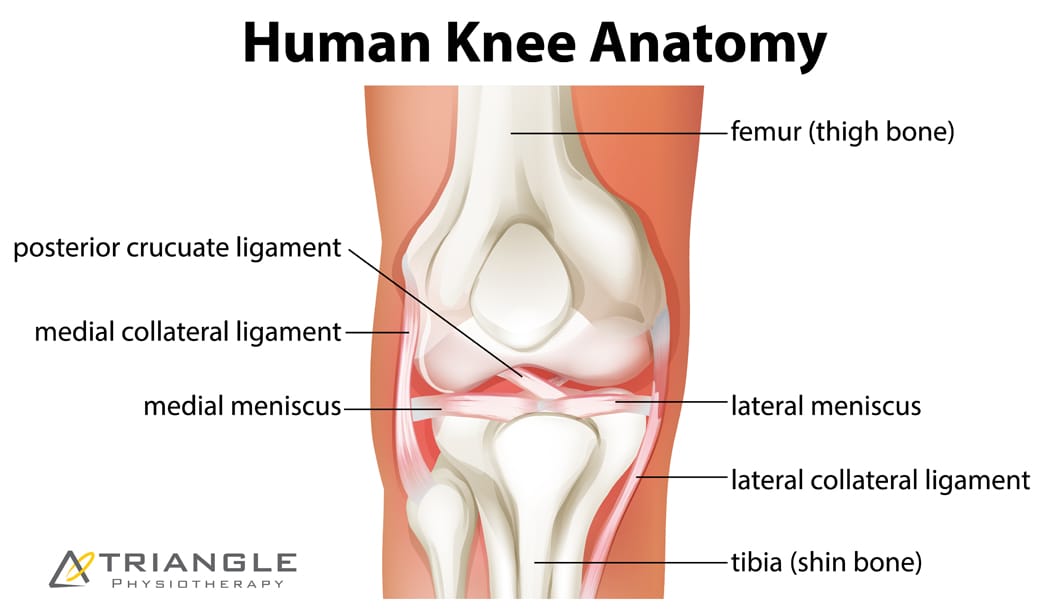
How does physiotherapy help with knee pain?
Here are some ways in which physiotherapy can help with knee pain:
- Pain management: Physiotherapists can utilize various modalities such as manual therapy, heat or cold therapy, and electrical stimulation to help alleviate pain and reduce inflammation in the knee joint.
- Exercise prescription: Specific exercises can be prescribed to strengthen the muscles around the knee joint, improve flexibility, and enhance joint stability. These exercises help restore normal movement patterns, reduce stress on the knee joint, and promote healing.
- Manual therapy: Physiotherapists may use hands-on techniques like joint mobilization or soft tissue massage to improve joint mobility, reduce muscle tension, and enhance circulation in the knee area.
- Education and self-management: Physiotherapists provide education about proper body mechanics, posture, and ergonomics to prevent further knee pain or injury. They may also offer guidance on activity modification and self-management strategies to promote long-term knee health.
- Assistive devices and bracing: If necessary, physiotherapists can recommend and provide appropriate assistive devices such as knee braces or orthotics to support the knee joint and reduce pain during movement.
What are the causes of knee pain?
Knee pain can have various causes, ranging from acute injuries to chronic conditions. Here are some common causes of knee pain:
- Acute injuries: Knee pain can result from sudden injuries, such as sprains, strains, ligament tears (such as anterior cruciate ligament or ACL tears), meniscus tears, or fractures. These injuries often occur during sports activities, accidents, or falls.
- Overuse or repetitive strain: Repetitive activities or excessive stress on the knee joint can lead to overuse injuries. Examples include patellofemoral pain syndrome (pain around the front of the knee), iliotibial band syndrome (inflammation of the band of tissue on the outside of the knee), or tendinitis (inflammation of a tendon, such as patellar tendinitis or jumper’s knee).
- Osteoarthritis: This is a degenerative joint disease characterized by the breakdown of cartilage in the knee joint. It is more common in older individuals and can cause knee pain, stiffness, and swelling.
- Rheumatoid arthritis: Unlike osteoarthritis, rheumatoid arthritis is an autoimmune condition that causes inflammation and damage to the joints, including the knee. It can lead to chronic pain, joint deformity, and functional limitations.
- Bursitis: Bursae are small fluid-filled sacs that cushion and reduce friction between tendons, ligaments, and bones. When the bursae become inflamed (bursitis), it can cause knee pain, swelling, and limited mobility.
- Patellar dislocation or instability: This occurs when the kneecap (patella) slips out of its normal position, often due to a sudden change in direction or a direct blow to the knee. It can cause severe pain, swelling, and instability.
- Gout: Gout is a type of arthritis caused by the buildup of uric acid crystals in the joints. It can affect the knee joint, leading to sudden and intense pain, redness, and swelling.
- Tumors: Although rare, tumors can develop in the bones or soft tissues around the knee joint, leading to knee pain and swelling.
What are some of the conditions associated with knee pain?
Some of the conditions associated with knee pain are:
- Patellar Tendonitis
- Patellofemoral Syndrome
- Osgood Schlatter Syndrome
- Knee Bursitis
- Knee osteoarthritis
- Baker’s Cyst
- Knee Ligament Injuries
How to treat knee pain at home
You can treat knee pain at home by doing some of the following:
- Rest: Avoid activities that aggravate the pain and give your knee sufficient rest. This can help reduce inflammation and promote healing.
- Ice therapy: Apply ice packs wrapped in a thin cloth to the affected knee for about 15-20 minutes at a time, several times a day. This can help reduce pain and swelling. Be sure to allow your knee to warm up between icing sessions.
- Compression: Use a compression bandage or knee brace to provide support and reduce swelling. However, make sure it’s not too tight to restrict circulation.
- Elevation: Elevate your leg and place a pillow under your knee to help reduce swelling.
- Over-the-counter pain relievers: Nonsteroidal anti-inflammatory drugs (NSAIDs), such as ibuprofen or naproxen, can help relieve pain and reduce inflammation. Follow the instructions on the package and consult with a pharmacist if you have any concerns.
- Gentle exercises: Once the acute pain and swelling have subsided, gentle range-of-motion exercises and stretching can help improve mobility and reduce stiffness. However, avoid any exercises that cause pain or discomfort. Consult with a physiotherapist for appropriate exercises.
If you’re experiencing knee pain, it’s recommended to consult with a healthcare professional, such as a physician or physiotherapist, for an accurate diagnosis and appropriate treatment.
Click HERE to book an appointment with a physiotherapist at one of our eight locations.
- Physiotherapy Etobicoke – Triangle Physiotherapy Etobicoke
- Oakville Physiotherapy Clinic – Triangle Physiotherapy Oakville
- Physiotherapy North York – Triangle Physiotherapy North York
- Mississauga Physiotherapy Clinics – Triangle Physiotherapy Mississauga
- Downtown Physiotherapy Clinics – Triangle Physiotherapy King West
- Uptown Physiotherapy Clinics – Triangle Physiotherapy Lawrence Park
- Physiotherapy Clinic Downtown Toronto – Triangle Physiotherapy Queens Quay
- Physiotherapy Clinics Mississauga – Triangle Physiotherapy Erin Mills
“Physiotherapy is a highly effective approach for managing and alleviating knee pain, whether due to injury or chronic conditions. Triangle Physiotherapy provides expert care across the GTA, including Physiotherapy in Etobicoke, Oakville, North York, Toronto, Lawrence Park, Queens Quay, Erin Mills, Mississauga, and Liberty Village. Our experienced physiotherapists can develop a personalized treatment plan to help you reduce pain, improve mobility, and enhance your quality of life.”
Physiotherapy is an evidence-based regulated healthcare profession that aims to maintain, restore and improve your function after disease or injury, so you can get back to doing what you love and enjoy an injury-free lifestyle that doesn’t hold you back.
Physiotherapists are primary healthcare professionals with a significant role in health promotion and treatment of injury and disease.
They combine their in-depth knowledge of the body and how it works with specialized hands-on clinical skills to assess, diagnose and treat symptoms of illness, injury, or disability.
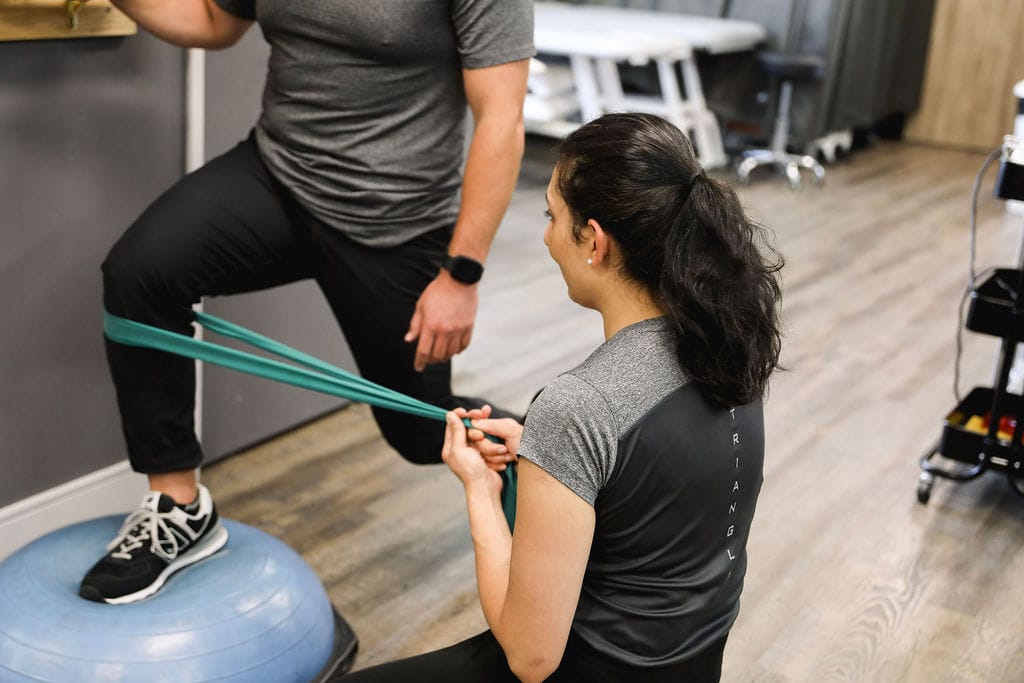
What is the average cost of physiotherapy near me?
The cost of physiotherapy depends on the appointment type and setting.
An initial assessment at a private practice typically costs between $120 to $150 in the Greater Toronto Area. Follow-ups at a private practice may cost between $80 and $110 per session. The numbers will vary based on the location of the clinics and various other factors.
What are the contributing factors to the cost of physiotherapy near me?
The cost of physiotherapy services is driven by factors such as:
- Type of service provided
- Length of session
- Physiotherapist’s specialty (Pelvic Health, Vestibular, and Concussion Rehab)
- The geographical location of the clinic
- Insurance reimbursement rates
Does insurance cover Physiotherapy?
Insurance plans may cover physiotherapy but every insurance plan is different, so, it may be prudent to check the details of your plan. Some questions to ask your insurance provider are:
- What is the annual coverage limit for physiotherapy?
- Is there a per-visit maximum, if any?
- Are there any required co-payments?
- Is the fee covered 100%?
- Is there a deductible?
How much will my physiotherapy treatments cost in total?
The cost of physiotherapy depends on the type and complexity of your injury or condition that is being treated as well as the treatment plan that your physiotherapist designs for you while keeping in mind your goals for recovery.
Why do I need to be treated by a registered physiotherapist?
It is of utmost importance to ensure that you are being seen by a registered Physiotherapist because behind every registered Physiotherapist are years of academic and clinical training as well as extensive knowledge of all the systems of the human body. At our physiotherapy center, we guarantee that every single physiotherapist we have is registered with the College of Physiotherapists of Ontario and will take excellent care of you.
Who do I speak to about the cost of physiotherapy near me?
Contact our patient care coordinator team at any of our eight locations. They will help you with any insurance-related questions you may have as well as match you with a physiotherapist best suited for your injury or condition.
Is it worth it to see a physiotherapist?
Seeing a physiotherapist can be very beneficial in many situations. Physiotherapy is a healthcare profession that focuses on improving and restoring physical function and mobility. Whether it’s addressing a specific injury, managing chronic pain, or enhancing overall physical well-being, a physiotherapist can provide valuable guidance and treatment.
Joining Physiotherapy Oakville offers you access to a team of skilled professionals who utilize evidence-based practices to tailor treatments to your specific needs. Scientific studies have shown that physiotherapy can significantly improve recovery times and physical outcomes. By becoming a part of Physiotherapy Oakville, you benefit from personalized care plans that enhance your physical health, help manage pain effectively, and support your overall well-being, ensuring you achieve the best possible outcomes.
Seein a physiotherapist costs less than what you would pay in terms of compromising your quality of life and being in pain.
Seeing a physiotherapist can help you:
- Get back to your favourite activity or sport
- Recover from an injury or surgery
- Get educated on how to exercise safely, manage painful episodes, improve your posture and more.
- Return to work after an injury
- Rehabilitate after an automobile accident
- Recover after childbirth
- and more.
Our More Locations
Physiotherapy Etobicoke | Physiotherapy Oakville | Physiotherapy North York | Physiotherapy Toronto | Physiotherapy Lawrence Park | Physiotherapy Mississauga | Physiotherapy Queens Quay | Physiotherapy Mississauga Erin Mills | Physiotherapy Liberty Village
Click HERE to book an appointment with a physiotherapist at one of our eight locations.
- Physiotherapy Etobicoke – Triangle Physiotherapy Etobicoke
- Oakville Physiotherapy Clinic – Triangle Physiotherapy Oakville
- Physiotherapy North York – Triangle Physiotherapy North York
- Mississauga Physiotherapy Clinics – Triangle Physiotherapy Mississauga
- Downtown Physiotherapy Clinics – Triangle Physiotherapy King West
- Uptown Physiotherapy Clinics – Triangle Physiotherapy Lawrence Park
- Physiotherapy Clinic Downtown Toronto – Triangle Physiotherapy Queens Quay
- Physiotherapy Clinics Mississauga – Triangle Physiotherapy Erin Mills
“Understanding the cost of physiotherapy is important for planning your treatment. Triangle Physiotherapy offers high-quality care across the GTA, including Physiotherapy in Etobicoke, Oakville, North York, Toronto, Lawrence Park, Queens Quay, Erin Mills, Mississauga, and Liberty Village. Our clinics provide transparent pricing and personalized treatment plans to ensure you receive the best care at a cost that works for you.”





